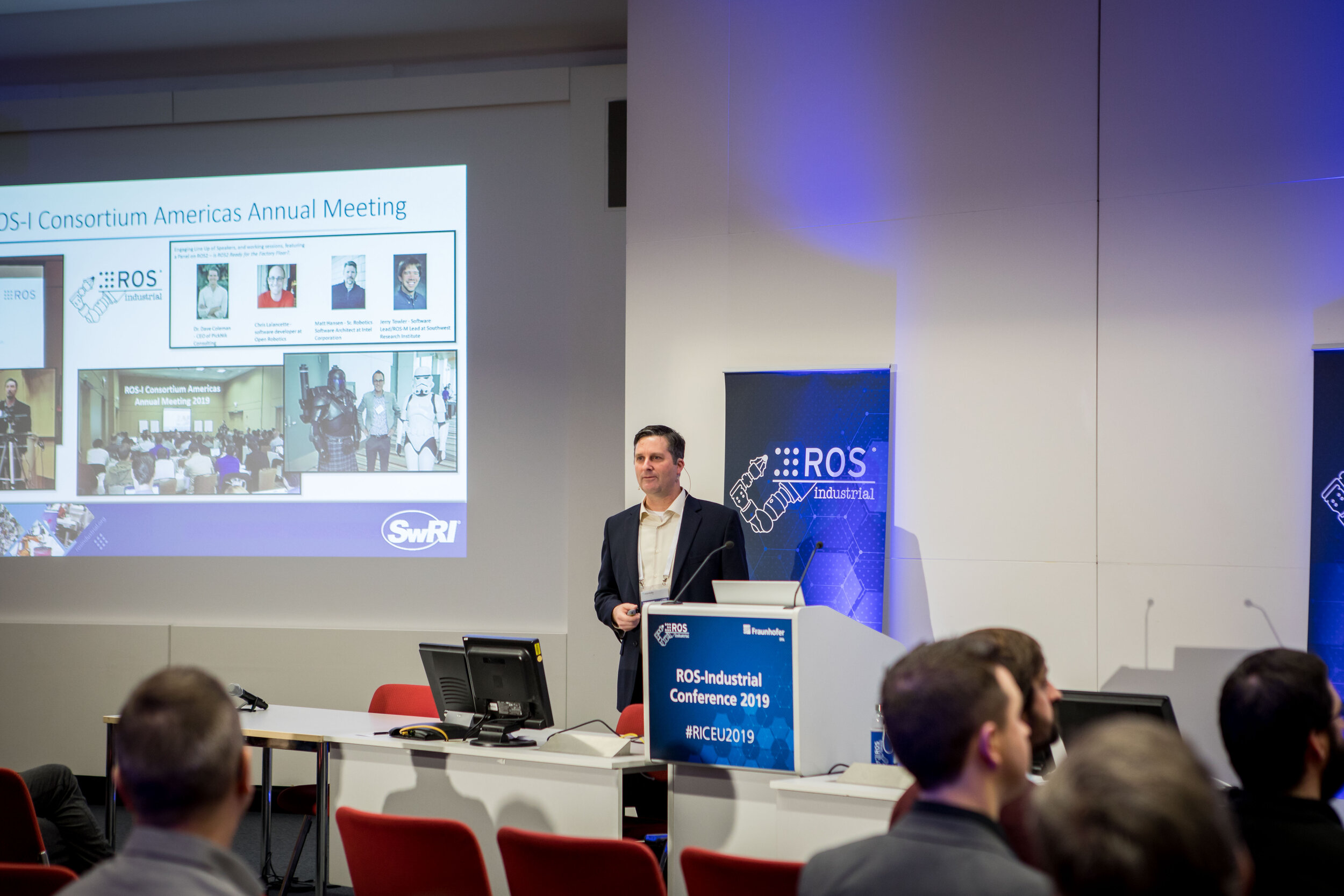This was ROS-Industrial Conference #RICEU2019 (Day 3)
/ROS-Industrial Conference 2019
December 10-12, 2019
Seven years after the very first public event entirely devoted to discussing the potential benefits of a shared, open-source framework for industrial robotics and automation, Fraunhofer IPA hosted the 7th edition of the ROS-Industrial Conference on December 10 to 12, 2019 (all slides and videos are linked under the program) .
This is the third instalment of a series of three consecutive blog posts, presenting content and discussions according to the event days including the follwing sessions:
Day 1 with “EU ROS Updates” (watch all talks in this YouTube playlist of Day 1)
Day 2 with “Software and System Integration” & “Robotics meets IT” (watch all talks in this YouTube Playlist of Day 2)
Day 3 with “Hardware and Application highlights” & “Platforms and Community” (watch all talks in this YouTube Playlist of Day 3)
Day 3: Hardware and Application Highlights
On the third and last conference day, speakers came from Universal Robot, KUKA, and Pilz just to name a few examples. The opening presentation held Paul Evans talking about ROS-Industrial North Americas updates and highlights from Southwest Research Institute (SwRI). He summed up ROS-Industrial activities including membership growth, ROS2 demo on booth at Automate 2019, meetings, trainings (focusing on ROS2), initiatives, community engagement… Some technical highlights are for example the Scan-N-Plan tools that enable real-time robot trajectory planning from 3D scan data. Within the project A5, robotic applications for the aerospace industry were developed, e.g. collaborative and adaptive solutions.
Aerospace manufacturing was also the key domain Rik Tonnaer from the research center “Smart Advanced Manufacturing XL“, cooperating with TU Delft, talked about. This industry is challenging for automation solutions because of the variety of processes, which almost all require human dexterity, craftsmanship, and adaptation to variations. In addition, there are large part sizes, similar but not identical products and processes and a long legacy of approved and certified processes. Using the example of a drilling process, Tonnaer demonstrated how an automation solution can be developed despite the challenges mentioned. The research center aims at deploying the first drilling systems beginning of 2021. Technology transfer to other industries is also on the agenda. ROS is their platform of choice to maximize reuse, collaboration, and separation info functional components.
Paul Evans (Southwest Research Institute / ROS-Industrial North America) presenting ROS-Industrial North America updates & SwRI application highlights
The third contribution came from robot manufacturer KUKA, a new prominent contributor to ROS. Thomas Ruehr started his presentation explaining how to interface KUKA robots with ROS via KUKA Robot Controller and KUKA System Software (KSS) as well as via KUKA Sunrise/RoboticsAPI. A product specifically benefiting from ROS is the navigation for the mobile manipulation platform KMR iiwa. Apart from that, there are already many KUKA robots running on ROS. The company is working on a more canonical offering with respect to a catalog of URDF models and official drivers for KSS, sunrise robots and the mobile platform. KUKA is actively asking the community for KUKA specific needs to help strengthen the company’s engagement in open-source software.
Another prominent robot manufacturer is heavily working on ROS support: Universal Robots. Anders Billesø Beck presented the new UR ROS driver addressing pre-existing hurdles like a clouded landscape with more than 200 variants of a ROS driver for UR and instability towards API changes. The new driver launched in October 2019 is the result of a Focused Technical Project with FZI Research Center for Information Technology that was funded by the EU project ROSIN (see presentation on day 1 for more information). Main advantages of the new driver are its ease of use and better performance and stability. The driver will remain open source and rely on future community contributions. It offers a stable control interface, teach-pendant integration, factory calibration in ROS, safety compliance speed scaling, eSeries tool communication and full safety compliance. UR is now working towards industrial-grade performance and stability.
In addition to the first lecture by Paul Evans, Erik Unemyr presented activities and application highlights from the ROS-Industrial Asia Pacific consortium managed by the Advanced Remanufacturing and Technology Centre (ARTC) of A*STAR (Agency for Science, Technology and Research) in Singapore. As is the case for Europe and North Americas, the Asia Pacific Consortium continues to support members, provide ROS trainings and other successful ROS events on a regular basis, and plans to offer ROS2 based trainings going forward. Unemyr covered a few of ARTC’s core robotics technology focus areas, including the mission to lower the technology barrier for adopting robotics for various applications. One way to achieve this is using a model-based teaching approach of robots using 3D computer vision. Another concept is using Augmented Reality teaching to enable simplified robotic use cases. The second highlight topic relate to providing more flexibility in automating high-mix applications that require toolpath generation. Unemyr also highlighted a key Singapore-sponsored project currently in development intended for large scale interoperable robotic deployments using ROS-enabled robots, called the Robotics Middleware Framework (RMF).
Erik Unemyr (Advanced Remanufacturing and Technology Centre (ARTC)) presenting ROS-Industrial Asia Pacific updates & ARTC application highlights
Stefan Doerr from Fraunhofer IPA presented the topic “Towards Plug & Play solutions for autonomous navigation of mobile robots and AGV”. The versatile navigation stack from his team does not need any markers or additional infrastructure, is mostly platform-, hardware- and sensor-independent and based on ROS. With its three core components long-term SLAM, zone-based global route planning and dynamic, local path and trajectory optimization the software has already been deployed on a variety of systems starting from vacuum cleaners and ending at autonomously driving trucks. Its plug & play technologies are the key to the widespread of mobile robots and AGVs in industry. The latest deployment of the software was successfully realized for Smart Transport Robots at BMW production plants. Challenges there were sparse sensor data, a highly variable environment with hardly any static structure, interaction with forklifts, trugger trains etc., large environments of more than 100,000 square meters and limited maneuverability. Ongoing research work at IPA is about machine learning for the navigation stack.
The company Pilz, well-known for its safety technologies, talked about its safety certified ROS-native industrial manipulator PRBT 6. Manuel Schoen presented the different modules for service robotics applications and how they benefit from ROS. The robot does not need any proprietary controller or teach-pendant but can be used directly with ROS. The safety controller for safety functionality is partially implemented in ROS as well. Since the robot itself in combination with the safety controller is certifiable under ISO 10218-1, the system integrator can focus on the application. Applications can be realized with the robot running automatically, running with manually reduced speed, or with manually high speed. In 2019, Pilz also presented results of a Focused Technical Project funded by the ROSIN project. The FTP implemented a trajectory generator with a MoveIt-interface for easy planning and execution of Cartesian standard-paths (LIN, PTP, CIRC) according to industrial requirements. In addition, the blending of multiple sequential motion commands was realized.
ROS is also entering the retail domain. This is done within the framework of the “REFILLs” project (Robotics Enabling Fully-Integrated Logistics Lines for Supermarkets). Jonathan Cacace from PRISMA Lab of University of Naples "Federico II" talked about the project’s aim: Novel robotics systems in close and smart collaboration with humans will allow addressing the main in-store logistics processes for retail stores, leading to a smarter self-refilling in supermarkets. Challenges like the changing environment, variety of objects, or tight work spaces have to be considered. To automatize for example the depalletizing of heterogeneous and cluttered objects, technologies like image processing, perception, grasping, and manipulation must be realized. Therefore, the ROS-based motion planner MoveIt plays a key role in the software development.
Manuel Schön (Pilz GmbH & Co. KG) presenting Safety Certified ROS-native Industrial Manipulator
Day 3: Platforms and Community
Coming to the end of the conference, Penny Scully from Jungle gave an overview about the offerings of the company. It aims at connecting industrial partners and robotics developers who offer “robofacturing”, a software defined manufacturing process of using robotics and AI technologies within the production of goods. Flexibility, time to market, and autonomy are main criteria of their offering. Jungle is developing an online platform to resell resolved challenges to a wider portfolio of industrial partners, like an app store for robotics, to extend their developers reach into the manufacturing industry. Processes like quality inspection, pressing, and trimming have already been implemented. Labelling, battery module assembly, and (un-)packing are in the future scope of the robofacturing process.
Benjamin Goldschmidt of Silexica highlighted its new SLX Analytics product. The German startup called attention to sporadic errors that occur in nowaday's complex software systems (e.g. an Autonomous Driving System). Because the complexity of such systems is so high, the developers are facing the challenge of understanding the overall system behaviour and knowing, in case of an error, which software component failed and why. With SLX Analytics, Silexica addresses these needs by providing automated testing of system metrics, enabling customers to uncover system-level defects early on and thereby reducing the risk of dangerous defects in the product. The first product release took place in January 2020.
The conference concluded with a contribution of the Eclipse Foundation summarizing the importance of open-source communities for robotics. Philippe Krief presented two company stories from Bosch and MQTT. Their lessons learned: Communities do not only help being competitive against “bigger fishes” but they are also a great vehicle to gain visibility and recognition. That is why Eclipse is launching an Industrial Robotics Working Group collaborating with different ROS-related research projects like RobMoSys, ROSIN, or SeRoNet. Krief’s motto “Open-Source is a journey, not a destination” does not only describe the work of the Eclipse Foundation very well, but is a nice closing word for the ROS-Industrial Conference 2019.
All three consortia, their members and managing institutes like Fraunhofer IPA are happy and proud to be part of this journey. Let us continue it for example with #RICEU2020! For some more impressions of the whole event please watch the event video.




















